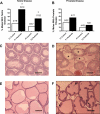Pesticide and insect repellent mixture (permethrin and DEET) induces epigenetic transgenerational inheritance of disease and sperm epimutations
- PMID: 22975477
- PMCID: PMC3513590
- DOI: 10.1016/j.reprotox.2012.08.010
Pesticide and insect repellent mixture (permethrin and DEET) induces epigenetic transgenerational inheritance of disease and sperm epimutations
Abstract
Environmental compounds are known to promote epigenetic transgenerational inheritance of disease. The current study was designed to determine if a "pesticide mixture" (pesticide permethrin and insect repellent N,N-diethyl-meta-toluamide, DEET) promotes epigenetic transgenerational inheritance of disease and associated DNA methylation epimutations in sperm. Gestating F0 generation female rats were exposed during fetal gonadal sex determination and the incidence of disease evaluated in F1 and F3 generations. There were significant increases in the incidence of total diseases in animals from pesticide lineage F1 and F3 generation animals. Pubertal abnormalities, testis disease, and ovarian disease (primordial follicle loss and polycystic ovarian disease) were increased in F3 generation animals. Analysis of the pesticide lineage F3 generation sperm epigenome identified 363 differential DNA methylation regions (DMR) termed epimutations. Observations demonstrate that a pesticide mixture (permethrin and DEET) can promote epigenetic transgenerational inheritance of adult onset disease and potential sperm epigenetic biomarkers for ancestral environmental exposures.
Copyright © 2012 Elsevier Inc. All rights reserved.
Figures







Similar articles
-
Pesticide methoxychlor promotes the epigenetic transgenerational inheritance of adult-onset disease through the female germline.PLoS One. 2014 Jul 24;9(7):e102091. doi: 10.1371/journal.pone.0102091. eCollection 2014. PLoS One. 2014. PMID: 25057798 Free PMC article.
-
Epigenome-wide association study for pesticide (Permethrin and DEET) induced DNA methylation epimutation biomarkers for specific transgenerational disease.Environ Health. 2020 Nov 4;19(1):109. doi: 10.1186/s12940-020-00666-y. Environ Health. 2020. PMID: 33148267 Free PMC article.
-
Transgenerational actions of environmental compounds on reproductive disease and identification of epigenetic biomarkers of ancestral exposures.PLoS One. 2012;7(2):e31901. doi: 10.1371/journal.pone.0031901. Epub 2012 Feb 28. PLoS One. 2012. PMID: 22389676 Free PMC article.
-
Combined exposure to DEET (N,N-diethyl-m-toluamide) and permethrin: pharmacokinetics and toxicological effects.J Toxicol Environ Health B Crit Rev. 2003 Jan-Feb;6(1):41-53. doi: 10.1080/10937400390155481. J Toxicol Environ Health B Crit Rev. 2003. PMID: 12587253 Review.
-
Neurological deficits induced by malathion, DEET, and permethrin, alone or in combination in adult rats.J Toxicol Environ Health A. 2004 Feb 27;67(4):331-56. doi: 10.1080/15287390490273569. J Toxicol Environ Health A. 2004. PMID: 14713564 Review.
Cited by
-
Assessment of Glyphosate Induced Epigenetic Transgenerational Inheritance of Pathologies and Sperm Epimutations: Generational Toxicology.Sci Rep. 2019 Apr 23;9(1):6372. doi: 10.1038/s41598-019-42860-0. Sci Rep. 2019. PMID: 31011160 Free PMC article.
-
Pesticide methoxychlor promotes the epigenetic transgenerational inheritance of adult-onset disease through the female germline.PLoS One. 2014 Jul 24;9(7):e102091. doi: 10.1371/journal.pone.0102091. eCollection 2014. PLoS One. 2014. PMID: 25057798 Free PMC article.
-
Transgenerational transmission of reproductive and metabolic dysfunction in the male progeny of polycystic ovary syndrome.Cell Rep Med. 2023 May 16;4(5):101035. doi: 10.1016/j.xcrm.2023.101035. Epub 2023 May 5. Cell Rep Med. 2023. PMID: 37148878 Free PMC article.
-
Generational comparisons (F1 versus F3) of vinclozolin induced epigenetic transgenerational inheritance of sperm differential DNA methylation regions (epimutations) using MeDIP-Seq.Environ Epigenet. 2017 Jul;3(3):dvx016. doi: 10.1093/eep/dvx016. Epub 2017 Aug 29. Environ Epigenet. 2017. PMID: 29147574 Free PMC article.
-
Epigenome-wide association study for pesticide (Permethrin and DEET) induced DNA methylation epimutation biomarkers for specific transgenerational disease.Environ Health. 2020 Nov 4;19(1):109. doi: 10.1186/s12940-020-00666-y. Environ Health. 2020. PMID: 33148267 Free PMC article.
References
-
- Kitchen LW, Lawrence KL, Coleman RE. The role of the United States military in the development of vector control products, including insect repellents, insecticides, and bed nets. J Vector Ecol. 2009;34:50–61. - PubMed
Publication types
MeSH terms
Substances
Grants and funding
LinkOut - more resources
Full Text Sources
Medical
Molecular Biology Databases
Miscellaneous

